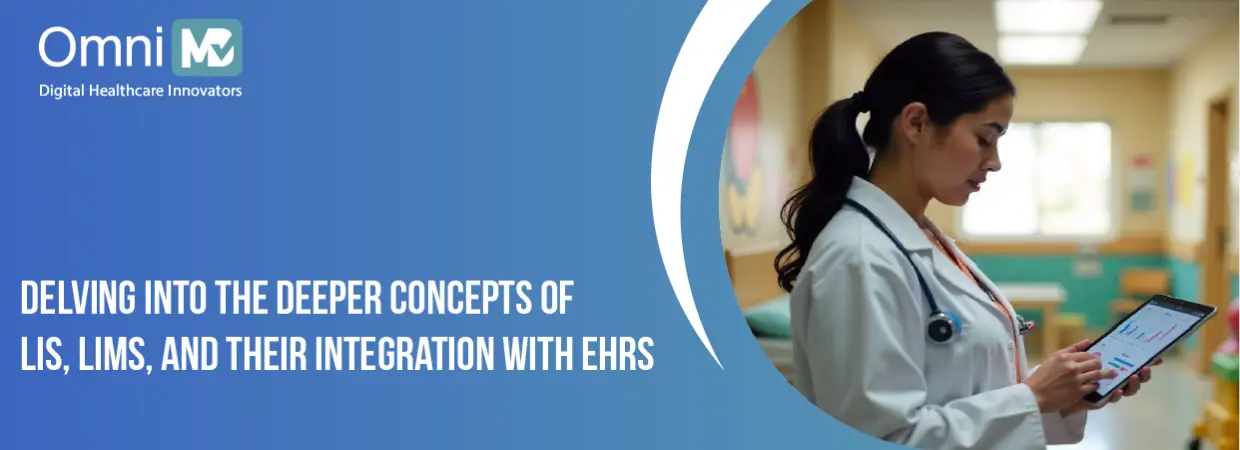Reimagining Lab Efficiency Through LIS and EHR Integration
Labs are among the most fast-paced environments in healthcare, processing hundreds of samples daily, usually under life-critical urgency. By the late 1970s and early 1980s, many labs had reached a breaking point due to surging patient volumes and increasingly complex test orders. Lab professionals were tasked with managing diverse tests across hematology, chemistry, and microbiology, each requiring distinctive handling and specialized equipment. Meanwhile, paper-based logs and manual workflows proved insufficient to keep up with the growing demands.
This pressure was further compounded by the rise of early automated lab equipment. Chemistry analyzers and hematology counters could suddenly generate results at a speed no human could manually record or verify in real-time. Data came faster than it could be logged. At the same time, labs were still relying on technicians to perform calculations (like creatinine clearance or anion gap), transcribe results, highlight critical values, and route information to the right physician. No doubt, the room for human error was enormous, and the cost of a single transcription mistake could be catastrophic. For instance, potassium result misread as 6.1 instead of 3.1 is powerful enough to change the course of treatment. In addition, turnaround times stretched from hours to days, accountability was difficult to trace, and clinical audits were virtually impossible.
This urgency to effectively manage the ever-growing volume of the patient data drove the inception of the Lab Information System (LIS). That means, unlike other healthcare innovations, LIS wasn’t a byproduct of EHR development but a parallel innovation born out of necessity. In other words, the technology was purpose-built to sit at the interaction between machines and humans, converting raw analyzer outputs into clinically meaningful results.
And standing true to its purpose, the LIS changed the dynamics from its very beginning. It enabled barcode-driven sample tracking, automated flagging for critical values, and real-time result verification tied to specific technicians or pathologists. As time progressed, it did more than just digitizing lab data, and evolved to standardize workflows, facilitate audits, improve traceability, and strengthen regulatory compliance.
However, despite all its advancements, LIS wasn’t the final stop. As diagnostic centers grew into multidisciplinary hubs, coordinating everything from clinical investigations to research trials, new questions materialized. Could a system track the entire journey of a sample and not just test results? Could it process intricacy without losing clarity? Calling for a new direction.
Why Did Labs Start Moving Toward LIMS?
As discussed, LIS is all about the patient, it was built with clinical interpretations in mind. LIMS, on the other hand, expanded on the LIS concept to also include research, pharma, environmental testing, and industrial quality labs, in addition to healthcare.Which implies, while LIS keeps patients at the center, LIMS is centered around the sample. It follows the entire journey of a sample, right from collection and testing to storage, inventory, and even chain-of-custody tracking. It also comes with tools for workflow setup, instrument integration, and data analysis. These features are especially vital in settings where audits, regulations, and reproducibility matter a lot more.
Though the only visible difference in terminology is the added ‘M’ for ‘Management,’ the change marks a big transition in perspective. And this change significantly affects patient care.
In labs that handle both clinical and non-clinical work, knowing whether you’re working with a LIS or a LIMS helps you understand how fast results will come through, how reliable the data is, and whether it’s safe to base treatment decisions on it. Confusing the two could lead to delays, miscommunication, or worse, using data that wasn’t meant for clinical use.
For instance, a LIMS might be required to save every detail, even failed test results, just in case of a future FDA audit. That’s not usually expected from a standard LIS. In the section below, we’ve navigated this meaningful crossroads.
Who Really Needs an LIS? Choose the Right System Based on Practice Size and Focus
The answer to who needs what kind of system, whether patient-centered or sample-focused, depends on your practice size, operational scope, and how central lab testing is to your daily workflow. So, now, let’s explore how these systems actually show up in the real world.
Solo Practitioners and Small Clinics
Most outpatient clinics and solo practices don’t have in-house labs. They rely on diagnostic giants like LabCorp or Quest or partner with local labs. Their focus is to get tests ordered fast and results even faster. For them, an LIS is more than enough as it efficiently handles electronic ordering, tracks test status, and brings results straight into the patient chart.
Installing a full LIMS in this setting would be unnecessary. Because these clinics aren’t managing samples internally, dealing with reagent inventory, or maintaining instruments. Their workflows are straightforward and patient-centric, making LIS a perfect fit.
Mid-Sized Hospitals and Multi-Specialty Practices
Hospitals that handle check-ups in-house gain a lot from having an LIS. It supports overseeing test turnaround times, lab technician workflows, and data quality. However, as these facilities transform and start offering specialized testing, say, molecular inspections or pharmacogenetics, they can consider incorporating LIMS features, too. But it shouldn’t be a full shift to LIMS. Think of it as LIS at the core, with LIMS-like add-ons to support growing layering.
Large Hospitals, Academic Centers, and Research Institutions
Now, this is where both systems usually coexist. A large hospital may have a clinical pathology lab powered by LIS and a translational research lab powered by LIMS, all under one roof. In these settings, LIS handles patient-facing diagnostics, while LIMS takes care of everything from clinical trials and biobanking to genomics and R&D workflows. They’re distinct systems but often feed into the same clinical narrative.
What Happens When These LIS Are Integrated with EHRs
So far we’ve seen how different practice sizes shape the need for an LIS versus a LIMS. But no matter where a provider sits on that spectrum, whether a solo practitioner ordering CBCs or a tertiary hospital running genomic panels, one constant remains. That constant is the EHR. All lab data ultimately needs to land here. Basically, it’s where care decisions are made, and without a close connection between the LIS and the EHR, even the most sophisticated lab setup risks becoming a silo.
To clarify, when there’s no integration between the EHR and the lab system, results may arrive as scanned PDFs, detached from the clinical context. There would be no room for automation, alerts, or trending. But with proper integration, the EHR turns into a dynamic clinical interface. HL7, FHIR, or custom APIs permit lab data to flow in real time, structured into discrete fields, and immediately actionable. Further, this transformation unlocks downstream automation, embeds clinical decision support, and powers analytics directly from within the provider’s workflow, impacting the patient care in following ways.
Faster Decisions, Better Outcomes
Test results are often the tipping point in clinical decisions. Integration makes those results instantly available, without the delays of faxes, phone calls, or scanning. That speed can change everything, from how quickly antibiotics are started to whether a patient with chest pain gets admitted or discharged.
It also enables longitudinal analysis. With integrated historical data, providers can track A1c over time, observe white blood cell trends post-chemo, or catch subtle shifts in creatinine levels that might otherwise be missed.
Patient Transparency and Trust
Patients today expect real-time updates. When lab results are automatically released to the patient portal, it builds transparency. Some systems go a step further, attaching interpretive comments or alerts to help patients understand what’s normal, what’s not, and what needs follow-up. That kind of digital bedside manner improves engagement and compliance.
Precision in Billing and Coding
Every lab test corresponds to CPT, LOINC, and often ICD-10 codes. Interoperable systems can automatically match the right codes to the test ordered and link them to the associated diagnosis. This drastically reduces claim denials caused by mismatches.
More importantly, for advanced tests, like next-gen sequencing panels or pharmacogenomics, specialized Z-codes may apply. Without integration, these codes are easily missed. With integration, billing accuracy improves, and reimbursement cycles become shorter and more predictable.
Clean Documentation for Claims and Audits
In value-based contracts or payer audits, traceability matters. Interfacing ensures that lab orders are authenticated, medically necessary, and properly documented. Everything, from the provider’s order to the result and the claim, is linked electronically.
Some payers even use lab results in risk scoring or quality metrics (e.g., HEDIS). Having that data available in discrete fields, not scanned attachments, makes population health reporting faster, cleaner, and audit-ready.
Fueling Value-Based Care Programs
Labs play a central role in chronic care and preventive screenings. Whether it’s A1c in diabetes, LDL in cardiovascular care, or INR for anticoagulated patients, lab results are outcome indicators.
An aggregated LIS-EHR setup allows this data to power dashboards, clinical reminders, and patient outreach. Care managers can proactively identify patients who missed routine tests, trigger automated messages, and document the follow-up, all based on real-time lab feeds.
How OmniMD is Redefining Lab-EHR Synergy in Modern Medicine
Every practice faces its own set of lab challenges. A dermatology clinic sending out biopsies to multiple third-party labs. A rural provider relies on regional hospital systems for advanced tests. A specialty group that suddenly scales its test volume after a payer contract update. The issue lies in how lab systems fail to communicate effectively with one another.
Lab data arrives in bits and pieces, some in HL7, some in XML or flat files. Without a standard bridge, providers resort to manual uploads, double-checks, and workarounds. Inconsistent data slows everything down, and patient care waits.
OmniMD Lab Exchange bridges the gap by standardizing inputs from various formats like JSON, CSV, XML, and HL7, converting them into compliant HL7 messages, and securely routing them to labs via protocols such as FTP/SFTP, TCP, or web services. It ensures diagnostic data flows without delay, without errors, and without manual friction.
Whether you’re a small clinic or a large multi-specialty network, we empower you to build a more connected, interoperable healthcare ecosystem. Let’s connect to discuss how we can help you.

Smarter Labs Start Here
LIS + EHR = Streamlined Success

 Written by Neha Singh
Written by Neha Singh
 Reviewed by Shivani Joshi
Reviewed by Shivani Joshi